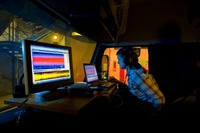Volvo’s sophisticated sound lab seeks the sound of silence
 The work carried out at Volvo Trucks’ sound lab is all about controlling noise levels. A truck driver experiences a variety of different sounds while working, some of which might be considered pleasant but, for the most part, the work of the sound engineers focuses on keeping unwelcome noise to a bare minimum.
The work carried out at Volvo Trucks’ sound lab is all about controlling noise levels. A truck driver experiences a variety of different sounds while working, some of which might be considered pleasant but, for the most part, the work of the sound engineers focuses on keeping unwelcome noise to a bare minimum. However, unlike many other areas relating to environment and safety, research into noise is not necessarily driven by legislation.
“The legal limit for noise in the work place in Sweden is 85 dB and we are already down to 70 dB inside the cab”, says Kaj Bodlund, a senior technology specialist working with product development on Volvo Trucks. “It’s a question of comfort and, even more importantly, safety.”
“Low, monotonous sounds are known to reduce brain activity,” adds Christina Keulemans, Feature Leader, In-Cab noise at Volvo Trucks. “The driver gets tired and, eventually, risks falling asleep.”
The noise made by on-board systems can also be disturbing, especially when drivers are trying to sleep or rest. Excessive noise from heaters, fans, air conditioning systems or refrigerators could prevent the driver from sleeping soundly. Drivers who are prevented from sleeping well are seldom the safest or most efficient on the road.
At Volvo Trucks’ sound lab at in Gothenburg, Sweden, noise can be tested in a variety of different ways. There are two sound chambers for engine noise, one for testing engine and transmission noise, an in-cab noise room, a reverberation chamber, as well as the vast main testing lab, where the noise made by a complete truck can be measured, using a simulated drive-by.
In the lab, tests are carried out using simulations, where a computer registers and measures the decibel levels. In-cab noise is measured using an artificial head with microphones in its ears. The measurements are extremely accurate and very realistic. Real tests are then performed on prototype trucks at Volvo Trucks’ proving ground outside Gothenburg.
“We started using simulations and artificial heads in the 1990s,” Kaj Bodlund recalls. “Now we can carry out more tests in less time and obtain more detailed data. In addition to decibels, we can also measure frequencies and several other aspects of the noise.”
Christina Keulemans adds, “In the lab we can separate different sounds. We can block everything else and just measure and analyse the noise made specifically by the engine, silencer or transmission system, for example.”
Since Kaj Bodlund began his work on noise at Volvo Trucks almost 20 years ago, a great deal has happened. Back in the early 1990s, in-cab noise levels of 74–75 dB were not uncommon, but today, they are down to a far more tolerable 70 dB.
A major breakthrough in noise research was made in 1993 with the introduction of the new FH range of Volvo trucks. The new, slim, aerodynamic cab was not only better from the point of view of fuel efficiency; it also considerably reduced wind noise. The air-tight sealing of the cab also reduced noise from the engine and the road.
“The new Globetrotter cab also represented a considerable improvement on the European market whilst, in the United States, it brought an even more radical breakthrough in sound-proofing compared with their existing products,” recalls Kaj Bodlund.
The next significant development for in-cab noise came in 2002. The Globetrotter cab was further improved by the addition of insulation between the sheet metal and the trim panel. This reduced condensation between the cab wall and the trim panels and improved temperature control inside the cab, as well as making a considerable difference to sound-proofing quality.
Over the years, the noise curve has progressed continuously downwards. At some point, it will begin to even out.
“We realise that there will come a point at which we can’t reduce the general noise levels any more, but there is plenty more work to do on more specific noise sources that may also impact the overall driving experience. Squeaking, creaking or scratching sounds can be equally unpleasant for the driver,” explains Christina Keulemans.
In 2006, a metal bolt was identified as the cause of a loud vibration in the transmission, due to its unfavourable positioning. The replacement of that single bolt enabled a considerable noise reduction, amounting to five decibels.
“Our work is continuous and we still have a great deal left to do,” Christina Keulemans emphasises. “Every time a design parameter is altered or a new product is developed, we have to analyse the way in which the change might affect the noise level.”
The way in which the human brain registers sound is subjective. Some sounds may be perceived as pleasant whereas others may be disagreeable. Different individuals experience noises in a variety of ways.
“In the future, we will not only develop ways of reducing noise,” notes Christina Keulemans. “We will also have an opportunity to create or emphasise sounds, depending on individual preferences.”
In surveys, most truck drivers want their truck to make as little noise as possible, to enable them to use their communication devices or listen to music without disturbance. However, some drivers have said that they still like to hear that the truck is powerful. Christina Keulemans envisages a future in which truck drivers will be able to request a designed sound, based on their individual preferences and their unique perception of what the sound means.
“For instance, a subdued, quiet, solid sound would probably represent luxury and quality, while a truck driver who appreciates a powerful engine might actually want to hear what 700 hp sounds like ! It’s all about dampening or highlighting different types of sound for different purposes, she concludes.”

